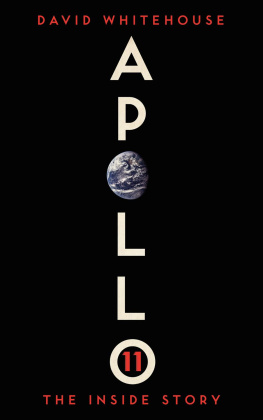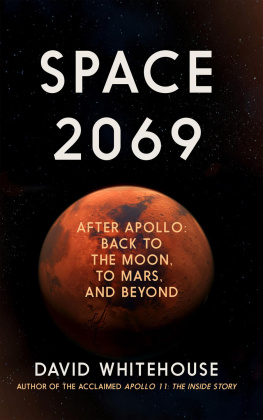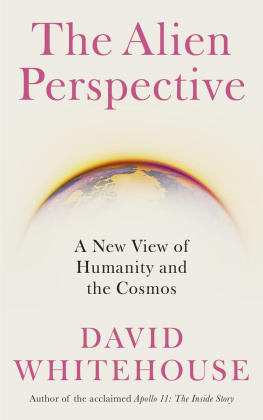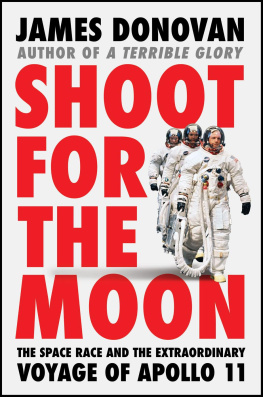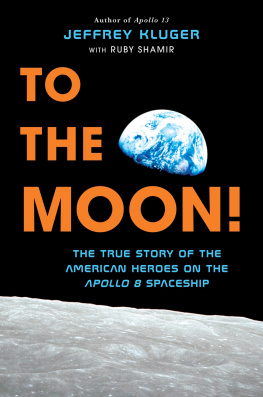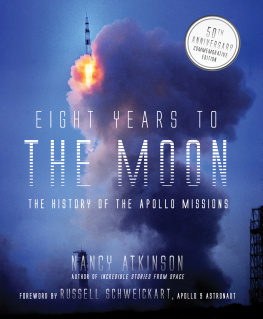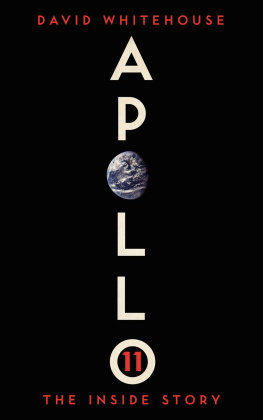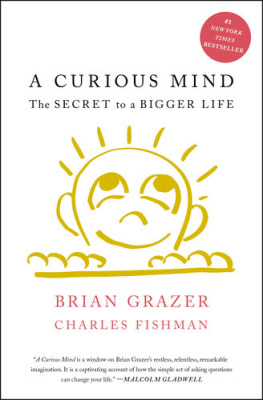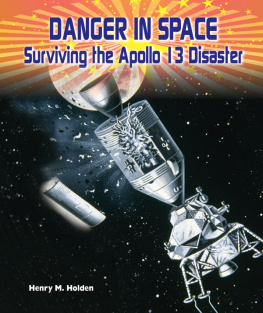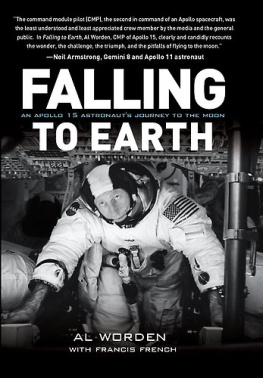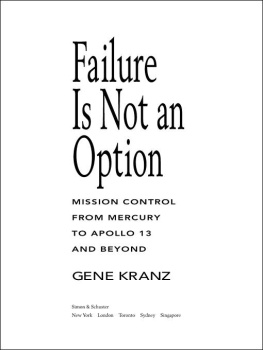It was my agent Laura Susijn who suggested I write this book. I, like many others, knew the 50th anniversary of the first Moon landing was approaching, and I anticipated many books about it would be written. I was a little reluctant to be one among many. But then I looked back into my archive, by which I mean sealed cardboard boxes stored in my loft. I soon realized that it was a goldmine of information. Over the more than 40 years since I was a young man I had been collecting. As I started my career as an astronomer at the Jodrell Bank radio observatory, I began to meet astronauts, engineers and officials involved in the Apollo project. Such meetings increased as I moved to the University of Londons Space Science department. As I became involved in the media I started to be invited to receptions, press conferences and dinners with a growing number of my childhood heroes. In 1988 I joined the BBC as science correspondent and soon realized it was a job that opened doors, and that people took my calls.
Some astronauts, like Neil Armstrong, treated writers with suspicion. He disliked articles that featured him as a personality. Other astronauts, well, they could talk and talk. Often I would hear them tell the familiar story they had been giving to journalists for years; I sat through that and hoped they would open up when I showed I had a deeper knowledge than most other science journalists. I remember Alan Shepard did that, pausing with a mischievous glint in his eye when I asked him an unexpected question. Sometimes it didnt work. More than one cosmonaut who had been involved in their Moon program pulled down the shutters when I asked something they considered awkward. Over the years I met all the moonwalkers and interviewed most of them, along with a great number of other astronauts and cosmonauts, administrators and officials. My boxes were full of tapes, notepads, press kits and much other stuff. Combined with what is available in NASAs extensive archive, I decided there was a book to be written that put the people first and used, as far as possible, the words of those involved.
I would like to thank Neil Armstrong, Buzz Aldrin, Gene Cernan, David Scott, John Young, Alan Shepard, James Lovell, Charlie Duke, Donn Eisele, Alan Bean, Gordon Cooper, Al Worden, Walt Cunningham, Tom Stafford, Dick Gordon, John Glenn, Pete Conrad, Edgar Mitchell, Richard Gordon, James Irwin, Stu Roosa, Ron Evans, Deke Slayton, Wally Schirra, James Fletcher, Thomas Paine, Joe Shea, Rocco Petrone, Brainerd Holmes, Bob Gilruth, George Mueller, James Webb, John Houbolt, Robert Seamans, Max Faget, William Pickering, Sergei Khrushchev, Viktor Savinykh, Georgi Grechko, Yuri Romanenko and Pavel Popovich.
I thank Laura Susijn for believing in this book and all those at Icon Books who made it a reality; also Nick Booth, who is a constant source of advice on space matters and good writing. He knows the life of a writer. More thanks than I can ever express go to my wife Jill and my children, Christopher, Lucy and Emily.
The night of the first landing on the Moon my father initially said I had to go to bed as the first footprint was scheduled for 3 am. I eventually talked him around, and watched transfixed on our black-and-white TV. I have never gotten over that night. My parents are no longer with me, but I hope they realized what that meant to a young boy. I think they did. I am sad that my children have not seen the like.
Spaceflight is dangerous. Everyone knew that. None more so than the astronauts, their families, and all those intimately involved in Apollo the project to land a man on the Moon. On that evening, 20 July 1969, everyone in Mission Control in Houston knew the danger. The lives of the two men about to attempt a descent to the lunar surface depended upon single moments, the single decision any of them might have to make in a second.
Gene Kranz, 31 years old, was the Flight Director for the landing. He was confident in his abilities, though not arrogant. His job was to run the show by being able to assimilate all the information coming into Mission Control from Eagle, the Lunar Lander. Formerly a fighter pilot and an engineer, he was leading a talented group. In front of him were rows of computer screens at which sat the mission controllers, all with their individual roles and names such as Guido and EECOM. Kranzs call sign was Flight. The average age of the men of Mission Control was only 26.
He selected a private loop only heard by the controllers. He didnt want anyone else to listen to what he was about to say. He waited a second and spoke:
Today is our day, and the hopes and dreams of the entire world are with us. This is our time and our place, and we will remember this day and what we do here always. In the next hour we will do something that has never been done before we will land an American on the Moon.
Less than an hour after those words were spoken, Neil Armstrong and Buzz Aldrin were 500 metres from the lunar surface in the region of the Sabine complex of small craters on the western shore of the Sea of Tranquillity. Armstrong was 38 and regarded as the best person to attempt the first landing. He had to put Eagle down within the next three minutes. Next to him was Edwin Buzz Aldrin, who was 39 years old. Ahead of them stretched the dark expanse of lunar night. No one, especially Armstrong himself, knew if they were going to make it. The landing was the goal; the moonwalk was secondary. Before he left Earth, he had told close colleagues that he had only a 50:50 chance of pulling off a successful landing.
In a few seconds Armstrong would have to take over and fly Eagle manually while looking for a suitable site. It was the most difficult thing any pilot had ever been asked to do. His heart rate was 160, double normal. He flexed his right hand around the joystick that controlled Eagles attitude, and his left hand around the thrust controller. He knew that this was never a job for a computer. The windows on the Eagle overhung the floor and were angled downwards so that he could lean against the tethers that tied him to the floor and look downwards.
On the right side of his body was Eagles control panel. Dials, gauges, switches and lights concerning all aspects of the Eagle from fuel to radar, attitude to rate of descent. Two buttons stood out, the only ones with a striped surround. One was labelled Abort, which sent the Eagle back up into orbit, and the other Abort Stage, which initiated an even more dangerous manoeuvre.
They were coming in from the east across the Sea of Tranquillity a misnomer as there were only dry rocks beneath them and with the low Sun behind them, the shadows were long and deeply dark. They had passed over rough ground a few minutes ago and were heading towards Tranquillitys southwestern region. They were long, or downrange. Between the lumpy gravity of the Moon and some extra speed picked up when they undocked from the Apollo Command Module, Eagle was at least a second ahead of its timeline and that translated into a mile too far. Armstrong had noticed the discrepancy immediately, Aldrin later said he hadnt and was impressed by his crewmates alertness. But just one second could make all the difference. The rocks below looked terrifying and the computer was taking Eagle directly into them. Armstrong took over manual control at 150 m, not 50 m as had been planned. He needed more time to look for a smooth landing site.
There was only enough fuel for one landing attempt, and that was running out fast. They were flying for their lives. Aldrin was too busy to look out of the window that was planned. He later said that if it wasnt on the dials he wasnt looking at it. He was looking upwards and to his left at the radar display with its altitude and rate of descent readings: Three hundred and fifty feet; down at four. Three hundred thirty, six and a half down. Youre pegged on horizontal velocity.

